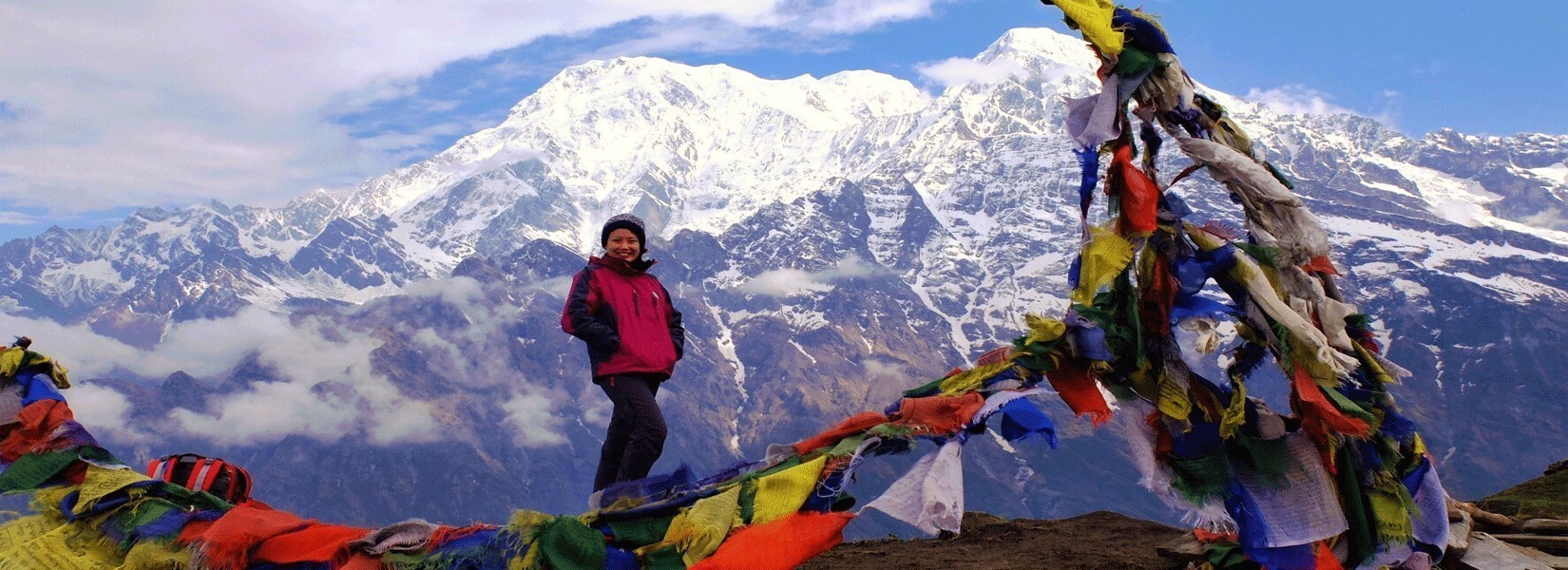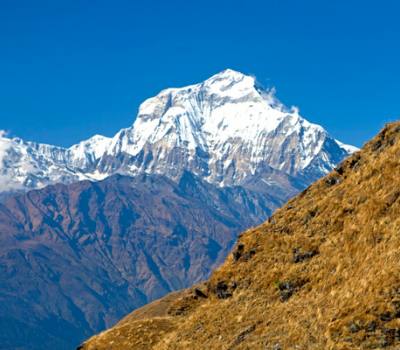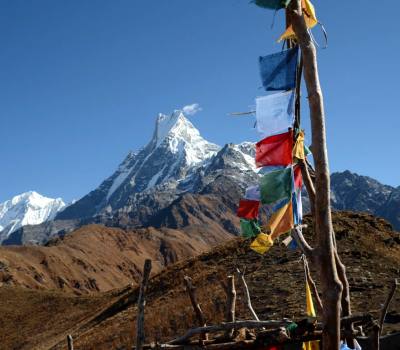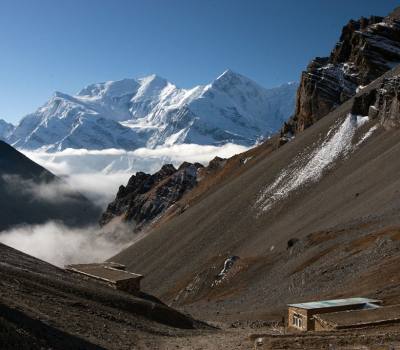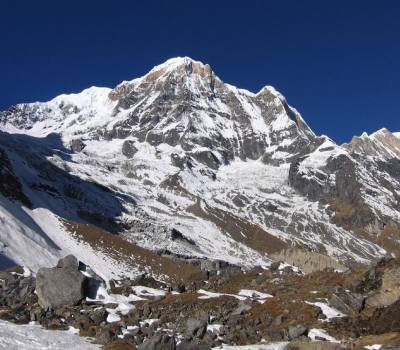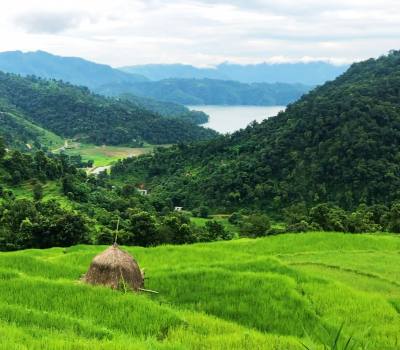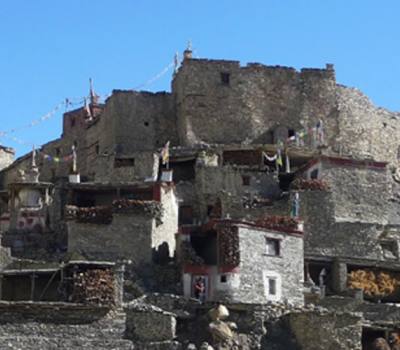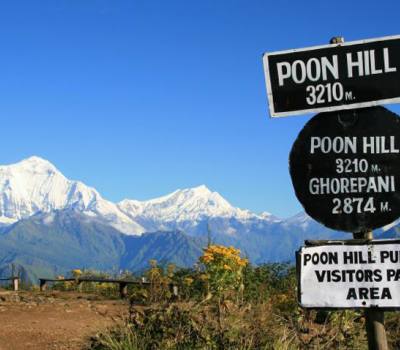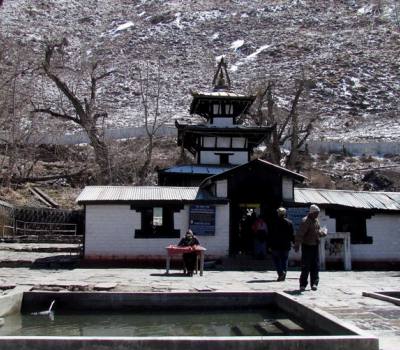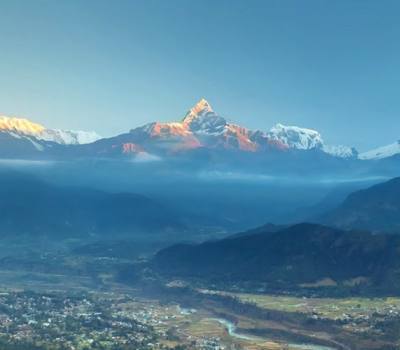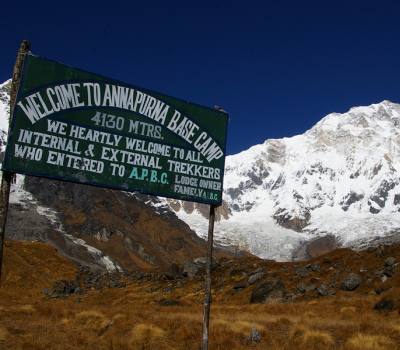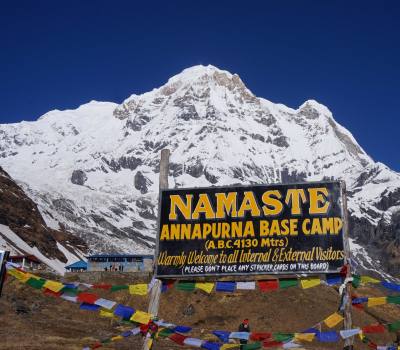Mardi Himal Trek 5 days cost
Begin on the enchanting Mardi Himal Trek, starting from the vibrant city of Pokhara. This 5-day trek begins with a scenic drive to Kande, the official starting point. From Kande, you'll journey through charming villages and lush vegetation, eventually arriving at Forest Camp, a serene hill camp nestled within a dense forest.
In just 5 days, you'll create countless special memories: the enchanting allure of Pokhara, the scenic drive to Kande, the exhilarating climb to Mardi Himal Base Camp, the serene mornings, the stunning snow-clad peaks, the lush green forests, the cozy teahouse nights, and the endless downhill trails. These moments will stay with you long after the trek ends.
Best Seasons and Trek Difficulty
Spring and Autumn are the best times to experience the Mardi Himal Trek. Rated as a moderate trek, it is suitable for individuals with standard fitness levels. No prior trekking experience is necessary. All you need is a spirit of adventure and good company to share this incredible journey.
After this, you will trek to Mardi Base Camp (4,500m), the highest and most spectacular part of the trek. The climb from Badal Danda to the base camp is challenging but incredibly rewarding. At the summit, you will be greeted with stunning, crystal-clear views of Mt. Annapurna, Mt. Machhapuchhre, and other majestic peaks. The breathtaking vistas of the surrounding mountains, hills, and expansive horizons will leave an indelible impression.
Trip Highlights of Mardi Himal Trek 5 days cost
The Mardi Himal Trek is a short yet spectacular trek in the Annapurna region, offering breathtaking views of the Annapurna range and a unique off-the-beaten-path experience. Here are the key highlights of the 5-day Mardi Himal Trek:
1. Majestic Mountain Views
- Close-up views of Mardi Himal, Machapuchare (Fishtail Mountain), Annapurna South, and Hiunchuli.
- Stunning sunrise and sunset vistas over the Annapurna massif from various vantage points.
2. Off-the-Beaten-Path Experience
- The trail is less crowded compared to the popular Annapurna Base Camp or Everest Base Camp treks, providing a more peaceful trekking experience.
- Pass through remote villages, forests, and alpine meadows.
3. Scenic Landscapes
- Trek through lush rhododendron forests, which are vibrant with blooming flowers, especially during the spring season.
- Enjoy diverse landscapes, from subtropical jungle to rugged alpine terrain.
4. Cultural Encounters
- Experience the warm hospitality of local Gurung and Magar communities.
- Stay in traditional teahouses, where you can learn about local culture, food, and way of life.
5. Base Camp Adventure
- Reach Mardi Himal Base Camp (4,500 meters), offering an exhilarating experience and a sense of accomplishment.
- The trek leads through a ridge that presents dramatic views of the surrounding peaks.
6. Accessibility
- Starting point of the trek is Kande, which is easily accessible from Pokhara by a short drive.
- It is one of the shorter treks, making it ideal for those with limited time or first-time trekkers seeking a Himalayan adventure.
Sample Itinerary for 5 Days:
- Day 1: Drive from Pokhara to Kande (1,770m), trek to Deurali (2,125m).
- Day 2: Trek from Deurali to Forest Camp (2,520m).
- Day 3: Trek from Forest Camp to High Camp (3,580m).
- Day 4: Hike from High Camp to Mardi Himal Base Camp (4,500m), return to High Camp.
- Day 5: Trek back to Siding Village and drive back to Pokhara.
The Mardi Himal Trek is perfect for trekkers looking for a short, scenic, and relatively less crowded experience in the Annapurna region.
Outline Itinerary:
- Day 01: Day 1: Drive from Pokhara to Kande and Trek to Forest Camp(2,550m)
- Day 02: Day 2: Trek from Forest camp to Badal Danda(2,970m)
- Day 03: Day 3: Trek from Badal Dada to Base Camp(4,500m) and Return to Badal Danda
- Day 04: Day 4: Trek from Badal Danda to Australian Camp(2060m)
- Day 05: Day 5: Trek from Australian Camp to Kande and Drive to Pokhara(822m)
Detail Itinerary
- Day 01 :Day 1: Drive from Pokhara to Kande and Trek to Forest Camp(2,550m) Begin your adventure with a scenic 45 minutes drive from Pokhara to Kande. The journey offers a glimpse of the stunning landscape you will be exploring on foot. Once in Kande, the trek officially begins.
The trail from Kande winds through picturesque villages and lush vegetation, immersing you in the natural beauty and local culture of the region. As you ascend, you'll pass through dense forests of oak and rhododendron, providing a refreshing and serene atmosphere.
After a 6-7 hour trek, you'll arrive at Forest Camp, a tranquil hill camp nestled within the forest. Here, you can rest and acclimatize while soaking in the peaceful surroundings. This first day sets the tone for the incredible journey ahead, blending scenic views, cultural encounters, and the serene ambiance of the forest. Over night at tea-house. - Day 02 :Day 2: Trek from Forest camp to Badal Danda(2,970m) On the second day of your Mardi Himal Trek, you'll continue your ascent from Forest Camp to Badal Danda. The journey takes about 5-6 hours and is filled with captivating natural beauty.
Leaving the serene Forest Camp behind, you'll trek through lush rhododendron and oak forests. As you climb higher, the dense forest starts to thin out, gradually giving way to more open and expansive views.
The trail to Badal Danda is moderately challenging but extremely rewarding. Upon reaching Badal Danda, you'll be greeted with panoramic views of the surrounding landscapes. This viewpoint offers stunning vistas of the Annapurna range, including the majestic Machhapuchhre (Fishtail) and other towering peaks.
Badal Danda, meaning "Cloud Hill," is aptly named for its breathtaking cloud formations and spectacular scenery. Here, you can relax, take in the stunning mountain views, and prepare for the exciting journey ahead. This day's trek highlights the diversity of the terrain and the ever-changing vistas that make the Mardi Himal Trek so special. over night at tea-house. - Day 03 :Day 3: Trek from Badal Dada to Base Camp(4,500m) and Return to Badal Danda On Day 3, you'll begin on the most exhilarating part of the Mardi Himal Trek, reaching the highest point at Mardi Himal Base Camp. The day begins early as you start your ascent from Badal Danda.
The trek to Mardi Himal Base Camp is challenging but incredibly rewarding. As you climb higher, the trail becomes steeper and more rugged, traversing alpine meadows and rocky terrains. The air is crisp, and the landscape becomes more dramatic with every step.
Upon reaching Mardi Himal Base Camp at 4,500 meters, you will be rewarded with stunning, panoramic views of some of the most iconic peaks in the Annapurna range. Marvel at the breathtaking, crystal-clear vistas of Mt. Annapurna, Mt. Machhapuchhre (Fishtail), and several other majestic peaks. The sheer grandeur of the Himalayan landscape will leave you in awe.
Take some time to soak in the spectacular scenery, capture photographs, and savor the sense of accomplishment. The Base Camp offers a unique perspective of the mountains, making it the highlight of the trek.
After spending quality time at the Base Camp, you'll begin your descent back to Badal Danda. The return journey allows you to experience the landscape from a different angle, with the changing light creating new and beautiful vistas.
By the end of the day, you will return to Badal Danda, where you can rest and reflect on the incredible journey to the highest point of the trek. This day is sure to be one of the most memorable, with its challenging climb and breathtaking rewards. Over night at Tea-house - Day 04 :Day 4: Trek from Badal Danda to Australian Camp(2060m) On Day 4, you'll begin your descent from Badal Danda to Australian Camp. This journey takes approximately 5-6 hours and offers a mix of beautiful landscapes and cultural experiences.
Leaving Badal Danda, you'll start your trek down through lush forests and scenic trails. The descent provides a different perspective on the landscape, allowing you to enjoy the diverse flora and fauna of the region. As you trek down, you'll pass through charming villages, giving you a glimpse of the local lifestyle and culture.
The trail gradually descends to Australian Camp, situated at an altitude of 2,060 meters. Australian Camp is known for its stunning panoramic views of the Annapurna and Dhaulagiri ranges, making it a perfect spot to relax and soak in the beauty of the Himalayas.
Upon reaching Australian Camp, you'll be greeted with comfortable accommodations and a serene environment. The camp offers breathtaking sunset views over the mountains, making it a picturesque end to your day's trek.
Spend the evening relaxing, reflecting on the journey so far, and enjoying the peaceful ambiance of Australian Camp. This day combines the thrill of trekking with the tranquility of nature, creating a memorable experience as you approach the final leg of your adventure. Over night at Tea-house. - Day 05 :Day 5: Trek from Australian Camp to Kande and Drive to Pokhara(822m) On the final day of your Mardi Himal Trek, you'll enjoy a short and pleasant trek from Australian Camp to Kande, followed by a scenic drive back to Pokhara.
Begin your day with a peaceful morning at Australian Camp, taking in the last views of the Annapurna and Dhaulagiri ranges. After breakfast, you'll start your descent towards Kande. The trek takes about 1-2 hours and passes through charming villages and terraced fields, offering a last glimpse of the beautiful Himalayan foothills.
Upon reaching Kande, you'll board a vehicle for a 45 minutes drive back to Pokhara. The drive is a relaxing end to your adventure, allowing you to reflect on the incredible journey you've just completed.
Arriving in Pokhara, you'll have the rest of the day to explore this vibrant city. Whether you choose to relax by Phewa Lake, visit local cafes, or explore the bustling streets, Pokhara offers a perfect blend of relaxation and entertainment.
This final day wraps up your 5-day Mardi Himal Trek, leaving you with unforgettable memories of stunning landscapes, challenging climbs, and the serene beauty of the Himalayas. Hotel in Pokhara
Cost Includes
- Airport pick-up and drop-off ( offer by company)
- Drop to Nayapul and Pick up from Nayapul by Private car or van or bus
- Trekking Accommodation, Twin Sharing in Basic Tea-house
- English-speaking guides/ Who has excellent knowledge.
- All meals( Breakfast, Lunch & Dinner) with hot tea
- Fresh Fruits after dinner every evening.
- Transportation to and from the trail head
- All necessary documents and permits for trekking
- Trekking equipment including sleeping bags
- Staff insurance, medication and equipment
- All Govt. and Local Taxes, First Aid Kit
- Beautiful T-shirts by Company
- Free Tripmap
- Special Caring
- Trekking Certificate by Destination Unlimited.
Cost Excludes
- International airfares, Kathmandu sightseeing and entrance fees
- Hotel in Kathmamdu and Pokhara
- Porters
- Travel/trekking insurance/ Nepal entry visa fees
- Domestic flights worth US$ 125 one way
- Mountain rescue charges or insurance
- Bottled drinks on trek (cold and alcoholic) and hot drinks which is not mentions above
- Lunches and dinners in Kathmandu and Pokhara
- Additional food or drink on trek in addition to three standard meals
- Personal expenses, Emergency Expenses, road blocked, snakes, desert.etc
- Which is not mention in email
- Tips(Tipping are expected)
1. What is the Mardi Himal Trek?
The Mardi Himal Trek is a scenic trekking route in the Annapurna region of Nepal, offering stunning views of the Himalayas including Mt. Annapurna, Mt. Machhapuchhre (Fishtail), and Mardi Himal itself. It's known for its relatively shorter duration and less crowded trails compared to other popular treks in the region.
2. How long does the Mardi Himal Trek take?
The Mardi Himal Trek typically takes about 5-7 days, depending on the itinerary and starting point. The standard 5-day itinerary is popular among trekkers looking to experience the highlights of the route.
3. What is the best time to do the Mardi Himal Trek?
The best times to do the Mardi Himal Trek are during the Spring (March to May) and Autumn (September to November) seasons. During these months, the weather is generally stable with clear skies, making it ideal for trekking and enjoying panoramic mountain views.
4. Is the Mardi Himal Trek difficult?
The Mardi Himal Trek is considered moderate in terms of difficulty. While it does involve uphill climbs and varying terrain, it is suitable for individuals with a moderate level of fitness. Trekkers should be prepared for some steep sections and altitude changes, especially when ascending to Mardi Himal Base Camp.
5. What is the altitude of Mardi Himal Base Camp?
Mardi Himal Base Camp is situated at an altitude of approximately 4,500 meters (14,764 feet) above sea level. It offers spectacular views of the Annapurna range and is the highest point reached during the trek.
6. Do I need a guide for the Mardi Himal Trek?
While it's not mandatory to have a guide for the Mardi Himal Trek, it is highly recommended, especially for those without prior trekking experience in Nepal. A guide can provide local expertise, ensure safety on the trail, navigate routes, and offer insights into the culture and environment.
7. What permits are required for the Mardi Himal Trek?
For the Mardi Himal Trek, you will need the Annapurna Conservation Area Permit (ACAP) and the Trekkers' Information Management System (TIMS) card. These permits can be obtained through registered trekking agencies in Nepal or from the Nepal Tourism Board in Kathmandu or Pokhara.
8. What kind of accommodation can I expect during the trek?
Accommodation along the Mardi Himal Trek ranges from basic teahouses to more comfortable lodges. Teahouses typically offer simple rooms with basic amenities such as beds, blankets, and meals (often Dal Bhat - rice and lentil soup). Lodges at higher altitudes may have shared bathrooms and limited electricity, so it's advisable to bring a sleeping bag and headlamp.
9. Is altitude sickness a concern on the Mardi Himal Trek?
Altitude sickness can be a concern on any trek that involves ascending to higher altitudes. It's important to acclimatize properly, stay hydrated, and ascend gradually to minimize the risk. Symptoms of altitude sickness include headache, nausea, dizziness, and shortness of breath. If symptoms persist or worsen, descending to a lower altitude is necessary.
10. What should I pack for the Mardi Himal Trek?
Packing essentials for the Mardi Himal Trek include sturdy trekking boots, warm clothing layers, a down jacket, rain gear, a hat and gloves, sunscreen, sunglasses, a reusable water bottle or hydration system, personal toiletries, a first aid kit, and snacks. It's important to pack light but adequately for changing weather conditions and varying altitudes.
11. Can I combine the Mardi Himal Trek with other treks or activities?
Yes, the Mardi Himal Trek can be combined with other treks in the Annapurna region or activities such as a visit to Pokhara, paragliding, or exploring nearby villages and cultural sites. Pokhara serves as a gateway to various adventure activities and is a popular tourist destination in Nepal.
12. How do I prepare for the Mardi Himal Trek?
To prepare for the Mardi Himal Trek, it's recommended to engage in regular cardiovascular and strength training exercises several months before your trek. This helps improve endurance and stamina for the uphill climbs and varying terrain. Additionally, practicing hiking with a loaded backpack can help you get accustomed to trekking conditions.
Quick Enquiry
Key Information
-
Trip Cost US$ 380
-
Trip Duration 5 Days
-
Destination Nepal
-
Trip Difficulty Moderate
-
Trip Style Trekking
-
Accomodation Lodge to lodge
-
Max Altitude 4500
| No of people | Price P.P |
| 1-1 Pax | US$ 380 |
| 2-4 | US$ 370 |
| 6-8 | US$ 360 |
| 10-12 | US$ 350 |
Similar Trips
-
Khorpa Danda Trek Annapurna Dhaulagiri Community Trek
DURATION: 15 Days -
Mardi Himal Trek
DURATION: 11 Days -
Annapurna Circuit Trek cost
DURATION: 19 Days -
Short Annapurna Base Camp
DURATION: 10 Days -
Royal Trek
DURATION: 9 Days -
Nar Phu Valley Trek
DURATION: 19 Days -
Ghorepani Poon Hill Trek cost
DURATION: 10 Days -
Jomsom Muktinath Trekking
DURATION: 11 Days -
Dhampus Sarangkot Trek
DURATION: 8 Days -
Annapurna Base Camp Trek
DURATION: 15 Days -
Annapurna Base Camp trek 6 days cost
DURATION: 6 Days

